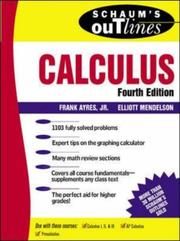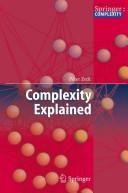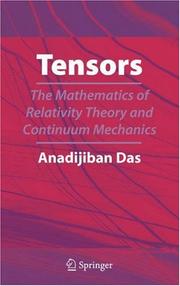| Listing 1 - 10 of 17 | << page >> |
Sort by
|

ISBN: 0070419736 Year: 1999 Publisher: New York McGraw-Hill
Abstract | Keywords | Export | Availability | Bookmark
 Loading...
Loading...Choose an application
- Reference Manager
- EndNote
- RefWorks (Direct export to RefWorks)
Mathematical analysis --- analyse (wiskunde) --- Calculus --- Calcul infinitésimal --- Problems, exercises, etc. --- Problèmes et exercices --- Wiskunde --- differentiaalvergelijkingen --- wiskundige functies --- Calcul infinitésimal --- Problèmes et exercices

ISBN: 9783540357773 3540357777 9783540357780 3540357785 3642071430 9786611118297 128111829X Year: 2008 Publisher: Berlin : Springer,
Abstract | Keywords | Export | Availability | Bookmark
 Loading...
Loading...Choose an application
- Reference Manager
- EndNote
- RefWorks (Direct export to RefWorks)
This book explains why complex systems research is important in understanding the structure, function and dynamics of complex natural and social phenomena. It illuminates how complex collective behavior emerges from the parts of a system, due to the interaction between the system and its environment. You will learn the basic concepts and methods of complex system research. It is shown that very different complex phenomena of nature and society can be analyzed and understood by nonlinear dynamics since many systems of very different fields, such as physics, chemistry, biology, economics, psychology and sociology etc. have similar architecture. "Complexity Explained" is not highly technical and mathematical, but teaches and uses the basic mathematical notions of dynamical system theory making the book useful for students of science majors and graduate courses, but it should be readable for a more general audience; actually for those, who ask: What complex systems really are?
Book
ISBN: 9783642140341 9783642140334 Year: 2010 Publisher: Heidelberg ; New York : Springer,
Abstract | Keywords | Export | Availability | Bookmark
 Loading...
Loading...Choose an application
- Reference Manager
- EndNote
- RefWorks (Direct export to RefWorks)
Cellular automata were introduced in the first half of the last century by John von Neumann who used them as theoretical models for self-reproducing machines. The authors present a self-contained exposition of the theory of cellular automata on groups and explore its deep connections with recent developments in geometric group theory, symbolic dynamics, and other branches of mathematics and theoretical computer science. The topics treated include in particular the Garden of Eden theorem for amenable groups, and the Gromov-Weiss surjunctivity theorem as well as the solution of the Kaplansky conjecture on the stable finiteness of group rings for sofic groups. The volume is entirely self-contained, with 10 appendices and more than 300 exercises, and appeals to a large audience including specialists as well as newcomers in the field. It provides a comprehensive account of recent progress in the theory of cellular automata based on the interplay between amenability, geometric and combinatorial group theory, symbolic dynamics and the algebraic theory of group rings which are treated here for the first time in book form.

ISBN: 9780387694696 9780387694689 Year: 2007 Publisher: New York : Springer,
Abstract | Keywords | Export | Availability | Bookmark
 Loading...
Loading...Choose an application
- Reference Manager
- EndNote
- RefWorks (Direct export to RefWorks)
Tensors: The Mathematics of Relativity Theory and Continuum Mechanics, by Anadijiban Das, emerged from courses taught over the years at the University College of Dublin, Carnegie-Mellon University and Simon Fraser University. This book will serve readers well as a modern introduction to the theories of tensor algebra and tensor analysis. Throughout Tensors, examples and worked-out problems are furnished from the theory of relativity and continuum mechanics. Topics covered in this book include, but are not limited to: -tensor algebra -differential manifold -tensor analysis -differential forms -connection forms -curvature tensors -Riemannian and pseudo-Riemannian manifolds The extensive presentation of the mathematical tools, examples and problems make the book a unique text for the pursuit of both the mathematical relativity theory and continuum mechanics.
Mathematical physics --- fysica --- wiskunde --- Tensor algebra. --- Calculus of tensors. --- Riemannian manifolds. --- Algèbre tensorielle --- Calcul tensoriel --- Riemann, Variétés de --- EPUB-LIV-FT LIVPHYSI SPRINGER-B
Book
ISBN: 9783540785729 9783540785712 Year: 2009 Publisher: Berlin : Springer,
Abstract | Keywords | Export | Availability | Bookmark
 Loading...
Loading...Choose an application
- Reference Manager
- EndNote
- RefWorks (Direct export to RefWorks)
While the original works on Malliavin calculus aimed to study the smoothness of densities of solutions to stochastic differential equations, this book has another goal. It portrays the most important and innovative applications in stochastic control and finance, such as hedging in complete and incomplete markets, optimisation in the presence of asymmetric information and also pricing and sensitivity analysis. In a self-contained fashion, both the Malliavin calculus with respect to Brownian motion and general Lévy type of noise are treated. Besides, forward integration is included and indeed extended to general Lévy processes. The forward integration is a recent development within anticipative stochastic calculus that, together with the Malliavin calculus, provides new methods for the study of insider trading problems. To allow more flexibility in the treatment of the mathematical tools, the generalization of Malliavin calculus to the white noise framework is also discussed. This book is a valuable resource for graduate students, lecturers in stochastic analysis and applied researchers.
financiële analyse --- Operational research. Game theory --- kansrekening --- Financial analysis --- Quantitative methods (economics) --- stochastische analyse --- Malliavin calculus --- Lévy processes --- Malliavin, Calcul de --- Lévy, Processus de --- EPUB-LIV-FT LIVMATHE LIVSTATI SPRINGER-B
Book
ISBN: 9783642021992 9783642021985 Year: 2009 Publisher: Berlin : Springer
Abstract | Keywords | Export | Availability | Bookmark
 Loading...
Loading...Choose an application
- Reference Manager
- EndNote
- RefWorks (Direct export to RefWorks)
Emergence and complexity refer to the appearance of higher-level properties and behaviours of a system that obviously comes from the collective dynamics of that system's components. These properties are not directly deductable from the lower-level motion of that system. Emergent properties are properties of the "whole'' that are not possessed by any of the individual parts making up that whole. Such phenomena exist in various domains and can be described, using complexity concepts and thematic knowledges. This book highlights complexity modelling through dynamical or behavioral systems. The pluridisciplinary purposes, developped along the chapters, are enable to design links between a wide-range of fundamental and applicative Sciences. Developing such links - instead of focusing on specific and narrow researches - is characteristic of the Science of Complexity that we try to promote by this contribution.
analyse (wiskunde) --- dynamica --- informatica --- informatietheorie --- Ergodic theory. Information theory --- Engineering sciences. Technology --- ingenieurswetenschappen --- Computer science --- Classical mechanics. Field theory --- Computational complexity. --- System analysis. --- Complexité de calcul (Informatique) --- Analyse de systèmes --- EPUB-LIV-FT LIVPHYSI SPRINGER-B
Book
ISBN: 9780817680862 9780817649906 Year: 2010 Publisher: Boston Birkhäuser Boston
Abstract | Keywords | Export | Availability | Bookmark
 Loading...
Loading...Choose an application
- Reference Manager
- EndNote
- RefWorks (Direct export to RefWorks)
Optimal Control brings together many of the important advances in 'nonsmooth' optimal control over the last several decades concerning necessary conditions, minimizer regularity, and global optimality conditions associated with the Hamilton-Jacobi equation. The book is largely self-contained and incorporates numerous simplifications and unifying features for the subject's key concepts and foundations. Features and Topics: * a comprehensive overview is provided for specialists and nonspecialists * authoritative, coherent, and accessible coverage of the role of nonsmooth analysis in investigating minimizing curves for optimal control * chapter coverage of dynamic programming and the regularity of minimizers * explains the necessary conditions for nonconvex problems This book is an excellent presentation of the foundations and applications of nonsmooth optimal control for postgraduates, researchers, and professionals in systems, control, optimization, and applied mathematics. ----- Each chapter contains a well-written introduction and notes. They include the author's deep insights on the subject matter and provide historical comments and guidance to related literature. This book may well become an important milestone in the literature of optimal control. Mathematical Reviews This remarkable book presents Optimal Control seen as a natural development of Calculus of Variations so as to deal with the control of engineering devices. ... Thanks to a great effort to be self-contained, it renders accessibly the subject to a wide audience. Therefore, it is recommended to all researchers and professionals interested in Optimal Control and its engineering and economic applications. It can serve as an excellent textbook for graduate courses in Optimal Control (with special emphasis on Nonsmooth Analysis). Automatica The book may be an essential resource for potential readers, experts in control and optimization, as well as postgraduates and applied mathematicians, and it will be valued for its accessibility and clear exposition. Applications of Mathematics
Mathematics. --- Systems Theory, Control. --- Control. --- Calculus of Variations and Optimal Control, Optimization. --- Systems theory. --- Mathématiques --- Calculus of variations. --- Control theory. --- Automatic control --- Mathematical optimization. --- Calcul des variations. --- Commande, Théorie de la. --- Commande automatique. --- Optimisation mathématique. --- Mathematical models. --- Modèles mathématiques --- Commande automatique --- Modèles mathématiques.
Book
ISBN: 9783642038228 9783540148876 Year: 2010 Publisher: Berlin Heidelberg Springer Berlin Heidelberg
Abstract | Keywords | Export | Availability | Bookmark
 Loading...
Loading...Choose an application
- Reference Manager
- EndNote
- RefWorks (Direct export to RefWorks)
Graph algorithms are easy to visualize and indeed there already exists a variety of packages and programs to animate the dynamics when solving problems from graph theory. Still, and somewhat surprisingly, it can be difficult to understand the ideas behind the algorithm from the dynamic display alone. CATBox consists of a software system for animating graph algorithms and a course book which we developed simultaneously. The software system presents both the algorithm and the graph and puts the user always in control of the actual code that is executed. He or she can set breakpoints, proceed in single steps and trace into subroutines. The graph, and additional auxiliary graphs like residual networks, are displayed and provide visual feedback. The course book, intended for readers at advanced undergraduate or graduate level, introduces the ideas and discusses the mathematical background necessary for understanding and verifying the correctness of the algorithms and their complexity. Computer exercises and examples replace the usual static pictures of algorithm dynamics. For this volume we have chosen solely algorithms for classical problems from combinatorial optimization, such as minimum spanning trees, shortest paths, maximum flows, minimum cost flows as well as weighted and unweighted matchings both for bipartite and non-bipartite graphs. We consider non-bipartite weighted matching, in particular in the geometrical case, a highlight of combinatorial optimization. In order to enable the reader to fully enjoy the beauty of the primal-dual solution algorithm for weighted matching, we present all mathematical material not only from the point of view of graph theory, but also with an emphasis on linear programming and its duality. This yields insightful and aesthetically pleasing pictures for matchings, but also for minimum spanning trees. You can find more information at http://schliep.org/CATBox/.
Mathematics. --- Combinatorics. --- Optimization. --- Operations Research, Mathematical Programming. --- Discrete Mathematics in Computer Science. --- Game Theory/Mathematical Methods. --- Computational complexity. --- Mathematical optimization. --- Operations research. --- Economics, Mathematical. --- Mathématiques --- Complexité de calcul (Informatique) --- Optimisation mathématique --- Recherche opérationnelle --- Mathématiques économiques --- Combinatorial optimization --- Graph algorithms. --- Data processing.
Book
ISBN: 9781138224155 1138224154 9781138224131 Year: 2019 Publisher: New York Routledge
Abstract | Keywords | Export | Availability | Bookmark
 Loading...
Loading...Choose an application
- Reference Manager
- EndNote
- RefWorks (Direct export to RefWorks)
Structures by Design: Thinking, Making, Breaking is a new type of structures textbook written for those who prefer to learn about buildings using hands-on, creative problem-solving techniques. Instead of focusing only on formulas and diagrams, this book teaches concepts before calculations and how principles of structural and material behavior can be applied to the design of effective, efficient, and expressive building designs. The book’s format makes it easy to adopt the content into a wide variety of courses that deal with building structures and architectural design. Each section of the book is focused on a particular manner by which structural resistance is provided: Form (Arches and Cables), Sections (Beams, Slabs, and Columns), Vectors (Trusses and Space Frames), Surfaces (Shells and Plates), and Frames (Connections and High-Rises). In each section, design exercises are shown which use a Think, Make, Break method of reiterative design. These examples demonstrate how to generate and evaluate different structural options for building designs using a variety of structural design tools including: the human body, physical models, historical precedents, static diagrams, traditional formulae, and advanced digital analysis. These examples range from introductory lessons of structural fundamentals to advanced techniques and systems. Each chapter includes potential lab exercises, questions for flipped classroom discussions, and suggestions for additional learning. More than 500 original illustrations and photos provide example solutions and inspiration for further design exploration.
Structural design --- Engineering design --- Architectural design --- Strains and stresses --- Architectuur --- Design thinking --- Ontwerpproces ; design --- 69(035) --- 373.67 --- Constructies ; structuren ; handboeken --- Constructie ; van gebouwen ; handboeken --- Bouwwezen. Constructie ; handboeken --- Onderwijs ; kunst- architectuuronderwijs --- Structural design. --- Constructions --- Calcul. --- design --- ontwerp --- ontwerpen --- ontwerpprincipes --- ontwerpmethodiek --- ontwerpproces --- meubelkunst --- meubelontwerp --- meubelmaken --- Meubels --- 710.9 --- architectuur, overige bijzondere onderwerpen
Book
ISBN: 9781848002296 1848002289 9781848002289 9786613250865 1848002297 1283250861 Year: 2008 Publisher: London : Springer,
Abstract | Keywords | Export | Availability | Bookmark
 Loading...
Loading...Choose an application
- Reference Manager
- EndNote
- RefWorks (Direct export to RefWorks)
The computer interpretation of line drawings is a classic problem in artificial intelligence and has inspired the development of some fundamental AI tools, including constraint propagation, probabilistic relaxation, tractable constraints, and (most recently) local simplification of optimisation problems. Based on the author’s considerable research experience, this book looks at line drawing interpretation and constraint satisfaction, covering several landmark results in the field. It contains state-of-the-art reviews of work in both drawing interpretation and discrete optimisation, and is not just restricted to drawings of polyhedral objects, but also covers complex curved objects. Its novel approach to drawing interpretation combines new constraints with recent advances in soft constraint programming. The book will become a standard reference in the field with its coverage of many theoretical results with formal proofs, particularly concerning necessary-and-sufficient conditions for realizability, simplification operations for combinatorial problems and tractability of drawing interpretation. Martin Cooper makes this fascinating topic accessible not only to computer scientists, but also to mathematicians, psychologists and cognitive scientists – indeed to anyone intrigued by optical illusions and impossible or ambiguous figures.
Computer Science. --- Computer Imaging, Vision, Pattern Recognition and Graphics. --- Computer-Aided Engineering (CAD, CAE) and Design. --- Mathematical Logic and Formal Languages. --- Image Processing and Computer Vision. --- Cognitive Psychology. --- Discrete Mathematics in Computer Science. --- Computer science. --- Computational complexity. --- Computer vision. --- Computer aided design. --- Consciousness. --- Informatique --- Complexité de calcul (Informatique) --- Vision par ordinateur --- Conception assistée par ordinateur --- Conscience --- Optical pattern recognition --- Computer graphics --- Engineering & Applied Sciences --- Applied Physics --- Optical pattern recognition. --- Computer graphics. --- Automatic drafting --- Graphic data processing --- Graphics, Computer --- Mathematical logic. --- Computer science --- Image processing. --- Computer-aided engineering. --- Cognitive psychology. --- Mathematics. --- Computer art --- Graphic arts --- Electronic data processing --- Engineering graphics --- Image processing --- Digital techniques --- Optical data processing --- Pattern perception --- Perceptrons --- Visual discrimination
| Listing 1 - 10 of 17 | << page >> |
Sort by
|

 Search
Search Feedback
Feedback About
About Help
Help News
News